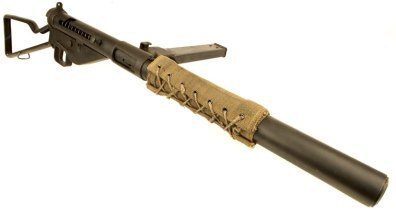Matthew S. Williams's Blog, page 41
August 4, 2014
Powered by the Sun: The “Energy Duck”
 Part of the challenge of paving the way towards a future where solar power is able to meet our energy needs is finding ways to integrate it into our daily lives. Basically, until such time as efficiency limits, storage and intermittency problems are truly overcome, one of the best ways to do this is to place photovoltaic arrays where the demand is highest and to get creative with how they collect it.
Part of the challenge of paving the way towards a future where solar power is able to meet our energy needs is finding ways to integrate it into our daily lives. Basically, until such time as efficiency limits, storage and intermittency problems are truly overcome, one of the best ways to do this is to place photovoltaic arrays where the demand is highest and to get creative with how they collect it.
For example, a group of British artists have conceptualized a giant solar harvesting floating duck as part of the 2014 Land Art Generator Initiative Copenhagen design competition. Dubbed “Energy Duck”, the giant structure has been designed not only to generate clean electricity for the local residents of Copenhagen, but to also provide a unique visitor center. In short, it comes renewable energy with a cautionary message about the effects of Climate Change.
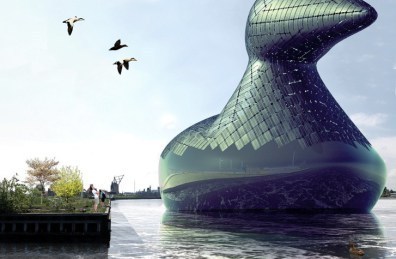 Inspired by the arctic eider duck, Energy Duck not only hopes to offer a unique renewable energy source, but also highlight the impact that climate change has had on the local population and breeding habitats of the eider duck in recent years. As its creators – Hareth Pochee, Adam Khan, Louis Leger and Patrick Fryer – explained:
Inspired by the arctic eider duck, Energy Duck not only hopes to offer a unique renewable energy source, but also highlight the impact that climate change has had on the local population and breeding habitats of the eider duck in recent years. As its creators – Hareth Pochee, Adam Khan, Louis Leger and Patrick Fryer – explained:
Energy Duck is an entertaining iconic sculpture, a renewable energy generator, a habitable tourist destination and a celebration of local wildlife.
Covered in photovoltaic panels, the Energy Duck is designed to harvest solar energy from every inch of its exterior shell. Solar cells mounted around the base are also positioned to take advantage of the sun’s rays being reflected off the water’s surface. Additionally, the facility features hydro turbines which use water pressure to provide stored energy to the grid after sunset and during the evening.
 All of this helps the Energy Duck overcome the all-important issue of intermittency. By being able to generate energy around the clock, the Duck is not dependent on the sun shining in order to continue operating and providing power. As the team explained:
All of this helps the Energy Duck overcome the all-important issue of intermittency. By being able to generate energy around the clock, the Duck is not dependent on the sun shining in order to continue operating and providing power. As the team explained:
When stored energy needs to be delivered, the duck is flooded through one or more hydro turbines to generate electricity, which is transmitted to the national grid by the same route as the PV panel-generated electricity. Solar energy is later used to pump the water back out of the duck, and buoyancy brings it to the surface. The floating height of the duck indicates the relative cost of electricity as a function of city-wide use: as demand peaks the duck sinks.
Inside the giant Energy Duck, visitors can get a unique look into the working mechanics of the hydro turbines, watching as the water levels rise and fall. Sunlight also filters through small spaces between the exterior solar panels, providing a kaleidoscope-like view of Copenhagen. However, another interesting feature about the Energy Duck is its environmental message.
 So while people are visiting the interior and taking note of the impressive technology, they will also be getting a lesson in why it is important. And really, the inherent message of the concept is really very appropriate. A clean, renewable, alternative energy source designed to look like, and inspired by, one of the many creatures that is endangered because of humanity’s dependence on unclean fuels.
So while people are visiting the interior and taking note of the impressive technology, they will also be getting a lesson in why it is important. And really, the inherent message of the concept is really very appropriate. A clean, renewable, alternative energy source designed to look like, and inspired by, one of the many creatures that is endangered because of humanity’s dependence on unclean fuels.
Now if we could just design a land-roving solar farm in the shape of a polar bear!
Sources: gizmag.com, inhabitat.com


August 3, 2014
Oscar Mike – Chapter Three
“In the long history of humankind (and animal kind, too) those who learned to collaborate and improvise most effectively have prevailed.”
-Charles Darwin
The room was flush with the aroma of metal filings and machine grease. And the acrid smell of burnt metal was also there, the telltale signs of forgers at work. The few open windows in the factory shop had managed to keep the air quality bearable, but it did nothing to remedy the heat situation. Whether it was the result of an unseasonably hot summer, or of melting down steel and nickel to make castings, the entire floor was predestined to feel like the eight ring of hell.
Braun’s obsessive face wiping could attest to that. His wet, clingy shirt and the way his khakis were sticking to his legs were another indication. He couldn’t imagine how anyone on the floor could stand the aprons, gloves and protective goggles they were forced to wear. Were it not for the hot metal components they were required to handle, he was sure they would all have stripped down to their skivvies a long time ago.
As they walked between stations on the assembly line, the foreman – the venerable Art Mitchell – showed him the fruits of their operation. Between wiping his face, Braun made entries in his notebook, noting the numbers and models produced.
“Our total haul for this past week was one-hundred and eighteen SMGs, eighty-nine service pistols, and two-hundred bayonets. Our intakes accounted for roughly two tons of recycled slag, a mix of steel, iron, nickel, tin and copper. And we managed to get just enough zinc from you people to fashion the firing pins.”
Braun nodded, making a note of it. He knew an appeal when he heard one, and would have to run that by the higher ups. Ever since they had set up shop, Mitchell and his workers had become the sole source of weapons and munitions for the town militias. His designs were seen on just about every city block now, the proliferation of weapons models that were well-dated, but ideally suited to modern needs.
But as always, expanded production meant that more resources would need to be obtained. The slag heaps and waste materials generated by the war could expect to keep producing plenty of iron and steel for the time being, but rare minerals and chemicals like zinc and chromium were quickly running out. Which meant resource extraction, in the old fashioned sense, would once again need to resume.
There were departmental rumors that some Smithsonite mines was being contemplated south of the capitol. Apparently, it was part a larger scheme to rebuild Socorro now that it too had been repopulated. But he could not say with any confidence that it was true, or assure Mitchell and his people that these proposed mines would become a ready source of zinc compounds, or even that they had a group of chemical engineers on hand that could extract it for him.
Such was the nature of things in his new role. He had learned to become a cog in an apparatus that was simply trying to get things done and see to a rising tide of production and manufacturing needs. At the center of it all was the rapidly expanding population of the region, people who had been fleeing the undead hordes and looking for a safe place to set down. Beyond simple shelter, food and water, all anyone had wanted back then was to know they could go to sleep at night and not spend their days in constant fear.
But now, with the cities of Santa Fe and Albuquerque resettled and rezoned, and dozens of townships besides, the more intricate matter of how to meet the less basic needs of their inhabitants was always on everyone’s mind. Beyond food, shelter and water, people were once again in need of basic comforts, and had to be organized to produce and distribute them. Braun heard much from each and every group he was tasked with listening to – the Agro Co-Op, Utilities, Weapons, and Materials – and knew much about their problems. But proposing solutions was beyond his pay grade. Gathering relevant information and making recommendations to those who actually had the power to do things, that was what he was he was tasked with. And according to those he reported to, it was a very important task.
Which reminded him – another thing in his job description was to investigate complaints made by other groups and see if he couldn’t find out what the source of the problem was. In this case, it was the people who kept track of weapons distribution that had asked him to inquire.
“I understand you experienced a drop in production back in early April.”
“Ah, yes,” said Mitchell, suddenly sounding grave.
“Okay. Any reason why that would be?”
“It’s simple, really. Our smelters and production lines run on electricity. And when the electrical grid is intermittent, our equipment stops working.”
“Right…”
Mitchell continued, still sounding and looking very much irate. “You may have heard about the brownouts we periodically deal with in town here? I know it’s not as common up north where you were from, but down here, it’s a way of life.”
“I’m sorry, sir. I’ll make a note of – ” he stopped short as his mind backtracked to the one nugget that stuck out in that last complaint. “How’d you know I was from up north?”
“Are you kidding?” Mitchell ran his hand up and down the length of Braun’s profile. “The buzz cut hair, the khaki pants, the way you walk… everything about you screams infantry, son. And people do talk.”
Braun frowned. “People have been talking about me?”
“Yeah. A lot of my workers were happy as hell to know that they were reporting to a former grunt now. They figured having someone who actually understood the nature their work, instead of some pencil-pushing bureaucrat, would make life easier.” The way Mitchell punctuated this with a grunt told him exactly what he thought of the end result.
“Well, as I said, I am new to this.”
“We all are, son. I guess we just do the best we can.”
Braun didn’t reply. Putting his pen to the pad again, he made the note, as promised. If he was going to avoid any such mistakes in the future, he needed to let his superiors know that they needed to do a better job of communicating with other departmental superiors. Otherwise, guys like him were going to wind up looking stupid in front of guys like Mitchell. He was sure to spell it in all uppercase letters and underline it twice.
BETTER INTERDEPARTMENTAL COMMUNICATION.
“Anyway,” Mitchell said, sounding suddenly uncertain. “What happened to get you stuck with us down here?”
“Long story,” Braun said hesitantly.
Mitchell chuckled. “Piss off the wrong person, huh?”
Again, Braun didn’t reply. Eventually, Mitchell nodded and let it drop.
“Shall I show you some of the fruits of our labor?”
Braun shook his head and tapped his pen against the notebook. “No, I think I got all the information I need right here.”
“I meant, would you like to see the firing range. We set one up so we could test fire every weapon that rolled off the line.”
Braun felt suddenly piqued. He hadn’t been expecting a hands-on demonstration. “That would be… lovely.”
A few minutes later, and Braun found himself in a large storage room on the buildings ground floor. The air was much cooler, and the smell immensely improved. Instead of the tangy odor of grease, filings and molten metal, there was the familiar smell of cordite.
They stood together, Mitchell and he, looking down range from a series targets – which in this case consisted of standing two by fours that held up sheets of foam insulation cut into the profile of men. Directly in front of them was a long counter covered with guns and open cases of ammunition. Braun recognized the three models: a short stock semi-auto rifle, a submachine gun that resembled an old STEN, and a Colt automatic.
The sum total of everything Mitchell and his crew had been working on since they first set up shop. Mitchell motioned to the nearest weapon, which happened to be a copy of their standard submachine gun. Braun stepped forward and took hold of the weapon. He noticed an inscription carved on the side.
Freak Killer 2.0
He raised the weapon to his shoulder, tested the sights and the weight.
“You recognize what that is, don’t you?” said Mitchell.
Braun nodded, lowered the weapon to get a better look at the assembly. In essence, the weapon was just a single, long tube of metal, a wiry metal stock, and a magazine sticking at right angles to it. The front end was especially long, thanks to the addition of the built-in suppressor.
“A venerable old design. How did you know how to recreate it so exactly?”
Mitchell crossed his arms. His tone became that of a proud father. “I had a set of the old blueprints at home. Metal working has always been my vocation, and old firearms my passion.”
“No wonder the Council saw fit to put you to work here.”
Mitchell laughed. “Well, the way they saw it, someone needed to be making sure we had a supply or replacement bullets. And no offense to your friends there, but most of our guns didn’t take five-five-six or nine millimeter ammo. Once they formed a militia, it just made more sense to create a standardized set of weapons and ammunition.”
“Hence the Freak Killer?”
Mitchell began speaking in proud tones again. “I was hard-pressed to come up with a model that was both easy enough to produce but reliable in the field, and simple enough to strip down and reassemble that someone could do it with a bare minimum of training. STENs were the perfect concept – designed with simplicity and a minimal number of components in mind.”
“Not to mention minimal expenditure of materials,” said Braun.
“Well observed. Perfectly suited to our purposes, wouldn’t you say?”
Braun raised the weapon again and chambered a round. He aimed at the nearest target, and squeezed. The weapon let off a metallic clack, and a small thunk sounded in the target down range. He took in, and let out, a small breath as he lowered the weapon, an old habit.
“Not bad,” he said. “And quiet too.”
“Stealth is another thing we non-military types take seriously. Loud gunshots have a way of drawing the infected to towards you. Don’t imagine you grunts ever worried about that, huh?”
Braun shrugged. “No. Drawing them in was kind of what we wanted to do. Easier to kill that way.”
Mitchell shook his head. “Well… you’re in our world now. Try to adapt.”


August 2, 2014
New Trailer: Teenage Mutant Ninja Turtles
 You ever see a trailer and think, “holy crap, that is the worst violation of my childhood that I will ever watch start to finish”? That was my feeling when watching the latest TMNT trailer, which was released late last month. Despite the abundant hints that this movie is going to be another Bay-backed atrocity, complete with racist caricatures, sexist portrayals, eye-candy visuals and stupid dialogue, I still felt kind of nostalgic seeing it.
You ever see a trailer and think, “holy crap, that is the worst violation of my childhood that I will ever watch start to finish”? That was my feeling when watching the latest TMNT trailer, which was released late last month. Despite the abundant hints that this movie is going to be another Bay-backed atrocity, complete with racist caricatures, sexist portrayals, eye-candy visuals and stupid dialogue, I still felt kind of nostalgic seeing it.
And there were some additional hints that told me this movie was going to totally suck. For starters, it is strongly implied yet again that the Turtles were created as some sort of covert project. It’s also strongly implied that “The Shredder” – the main antagonist in the TMNT universe – was a similar creation. Hell, they even go as far to say that he’s a damn robot with Wolverine-like retractable claws. What can I say to that except… NOOOOOO!
But like most fans who grew up with the Turtles, I was never looking to this movie to provide any kind of faithful reboot. In fact, when I heard Bay was doing a relaunch of the franchise, I believe I just rolled my eyes and filed it in the “could care less” category. So while I might get around to seeing this, I do not imagine for one second that I am expecting anything from it other than utter amusement.
Low expectations people, that’s the way to survive a Bay movie! Oh yeah, and enjoy the trailer:


August 1, 2014
Oscar Mike – Chapter Two
In such dangerous things as war the errors which proceed from a spirit of benevolence are the worst.
-General Karl von Clausewitz
Haynes gave his spine a quick adjustment, pushing his stomach out and driving his hands into the small of his back. Command vehicles were known for being cramped, but it felt like they had stuffed the entire HQ into the back of the vehicle and brought it with them. In front of him, a small table stacked with papers lay, and beyond that, the crew of the vehicle huddled amidst enough C and C and radio equipment to run a small army.
Appropriate, since that was precisely what they were doing. Sitting just to the rear of the staging area, the rear door down and letting in the morning air, General Haynes found himself surrounded by all the sights and sounds of an army ready to deploy. Though things were relatively calm at the moment, the energy was undeniable. Now was the time before everything hit the fan, when the tanks and troop carriers began to roll out and hit the field full on. It was a time of quiet contemplation, a time to nurse the last-minute thoughts and doubts.
A small clink a few feet away drew his attention away from the maps and assorted papers spread across the table. He looked up to see the eyes of a meek-looking Private setting a cup down before him, the thick brown contents sending steam wafting up towards him.
“Coffee, General?” he said, stepping back from the table.
“Thanks, Private,” Haynes said with a smile, and took a few generous sips. He noted the intense bitterness, but was thankful that it at least had some milk in it. Though they could hardly be accused of growing anything comparable to what had been available in the old days, the local farmers were still to be commended for trying their hand with coffee beans. And it was good to know that some luxuries were still afforded to them these days…
Placing the cup down, he went back to the first of several annotated maps before him. The first was map of the region’s main highway and the various towns that dotted the landscape, with Espanola featured most prominently in the upper right. On the one beneath it and sticking out at the edge, the 200th Infantry Brigade’s staging area was featured, as well as the comparatively small township of Sombrillo, and the first objective of the day. On these and the others that made up the pile, the name Rolling Thunder was scrawled in the lower right hand margin.
Around the map, several aerial photographs lay, all of them rendered in the bright white, black and grey hues of infrared.
The sight of these once again made him sigh, particularly the way the streets showed virtually no traces of heat signatures. None of the bright whites that denoted uninfected, or the mottled greys that usually denoted Whiskeys.
Beyond that, there were pictures taken by the same reconnaissance flight of the hamlets of Cuartelez and La Puebla. These were much the same, appearing dark except for a few patches which appeared to be fires burning themselves out in open areas. In all likelihood, these areas had been overrun, but they were not his main concern right now. Once the main objective had been taken, these areas could be cordoned off, cleared and repopulated with ease.
In the end, the first phase of the operation came down to Sombrillo. As the largest settlement, and the one that straddled the highway and connected several other arteries of traffic to it, it was the gateway. 2nd Battalion was already poised to push back in Espanola by the southern road, but to ensure that they enveloped all the infected inside the town, he needed 1st pushing in from the east. Only then could they expect to deal a permanent and crushing blow on the bastards, and ensure they could not possibly escape.
He looked once more at the image of Sombrillo. From all outward appearances, the walls were still intact, but that didn’t mean the infected couldn’t have found another way in. They were good that way, and it only ever took one…
It was little wonder then why he had organized their advance the way he had. Moving the photos aside, he looked back to the main map, studying the icons and lines of advance that were emblazoned on it. The units that made up the 200th Rattlensakes sat in the lower right corner, their designations printed beneath them. Reaching out, a long series of solid and dotted lines ran, representing the entirety of Rolling Thunder. Its every action and contingency, those that could be foreseen at any rate, planned out in detail.
“Sir?” another voice called to him. He looked up to see the face of Colonel Coombs standing there, his arms crossed behind his back. He knew instantly what he was about to say, but let him say it anyway. At moments like this, one had to respect the procedural details. They made things feel more official. “It’s time, sir.”
“Good,” he replied curtly. “Give the go order to all units. Commander order: Siren.”
“Yes, sir,” replied the Colonel, and turned around and stepped to the vehicles open rear door. Poking his head outside, he began barking orders to the communications crews sitting in their radio huts.
“All stations. Command order: Siren!”
The radio operators obliged and began calling the code word in. Within moments, the sounds of engines firing in the distance would be heard – an entire squadron of A-10s and AC-130s powering up their engines and getting ready to enter the target area to provide overwatch and close air support. Since they were based back in the capitol, the planes had a head start, and would begin deploying in waves to conserve fuel and ordinance for the big fight.
He checked his watch to mark the time. 0500 hours, right on schedule.
Within fifteen minutes, he would issue the second code word, Thunder, at which point, the ground forces would start moving.
Haynes took a deep breath and finished the last of his coffee. The charged liquid quickly entered his bloodstream, contributing to his already escalating heart rate. He had to admit, it felt good. After weeks of planning, preparing, and resupplying, the troops were finally committing to their first offensive under his leadership. The transition had been difficult, and he knew the grunts were nursing their own share of worries. But alas, they were his troops now. And watching them enter into their old stomping grounds and liberating it at last would finally silence any and all lingering doubts about who was in command.
I never asked to replace him¸ he thought, thinking at last of his fallen superior. But I will not shrink from the role that has been thrust upon me.
Perhaps, in time, Thur would recover fully and return to his old command. Until such time, Haynes knew he would do the job, and do it right. In his hands, the Rattlesnakes would emerge from this latest setback victorious. He couldn’t let it be otherwise…


Biomedical Breakthroughs: “Biological” Pacemakers
 Since they were first developed some forty years ago, pacemakers have served an invaluable medical function. By stimulating the heart with electrical stimulation, they ensure that the recipients heart continues to beat at a steady rate. However, the implantation process calls for a major medical procedure, and the presence of the machine inside the body can lead to complications – i.e. infections.
Since they were first developed some forty years ago, pacemakers have served an invaluable medical function. By stimulating the heart with electrical stimulation, they ensure that the recipients heart continues to beat at a steady rate. However, the implantation process calls for a major medical procedure, and the presence of the machine inside the body can lead to complications – i.e. infections.
Little wonder then why researchers are looking to create a better design to replace it with. However, up until now, proposed upgrades have focused on eliminating batteries (that require additional surgery to be replaced) with perpetual motion or piezeoelectric-powered devices. But this most recent proposal, which comes from the Cedars-Sinai Heart Institute in Los Angeles, looks to use the heart’s own cells to regulate it and keep it in working order.
 In an effort that was apparently the result of “dozens of years” worth of research, Dr. Eduardo Marbán and his research team used genes injected into the defective hearts of pigs to convert unspecialized heart cells into “biological pacemakers”. The pigs, all of which suffered from complete heart blocks, had the gene TBX18 injected into their hearts via what is described as a minimally invasive catheter procedure.
In an effort that was apparently the result of “dozens of years” worth of research, Dr. Eduardo Marbán and his research team used genes injected into the defective hearts of pigs to convert unspecialized heart cells into “biological pacemakers”. The pigs, all of which suffered from complete heart blocks, had the gene TBX18 injected into their hearts via what is described as a minimally invasive catheter procedure.
This caused some of the existing unspecialized cardiac cells to transform into sinuatrial node cells, which consist of tissue that initiates the electrical impulses that set the rhythm of the heart. The day after the procedure, the recipient pigs’ hearts were already beating faster than those of a control group and lasted for the duration of the 14-day study – indicating that the treatment could be a longer-term solution than previously thought.
 Initially, Marbán and his colleagues conceived of it more as a temporary fix for patients who were having problems with their man-made pacemakers. Now, they’re considering the possibility that it could be a long-term biological treatment. It could also be used on infants still in the womb, who can’t currently receive mechanical pacemakers. And while the research has so far been confined to pigs, human clinical studies could begin in as soon as three years.
Initially, Marbán and his colleagues conceived of it more as a temporary fix for patients who were having problems with their man-made pacemakers. Now, they’re considering the possibility that it could be a long-term biological treatment. It could also be used on infants still in the womb, who can’t currently receive mechanical pacemakers. And while the research has so far been confined to pigs, human clinical studies could begin in as soon as three years.
In keeping with a trends in modern medicine, this gene therapy offers a potential third alternative to medical machiners and biomimetics. The one seeks to enhance the workings of our biological bodies through the addition of machinery while the other seeks to create machinery that mimics the bodies natural functions. But by simply programming the body to perform the role of machinery, we can cut out the middle man.
Sources: gizmag.com, cedars-sinai.edu


July 31, 2014
Oscar Mike – Chapter One
Insanity: doing the same thing over and over again and expecting different results.
-Albert Einstein
His hand trembled as soon as the pen touched the paper. He had noticed the tremors as soon as he awoke, but somehow, committing to the act seemed to make it worse. He took a deep breath and pressed the pen’s tip to the paper harder, hoping the added pressure would steady it. But it still found enough room to wiggle on him, creating a small, indented scribble on the page. Removing it, he dropped the pen in his lap and began scratching at the skin on his left arm. At moments like this, the itching and phantom sensations became worse, and the sight of the prosthetic mounted at the end of it didn’t help.
He grunted as he scratched, trying to vent the frustration. How unacceptable was it that he couldn’t even start this simplest of tasks? Of all the things he had witnessed in recent years, all the things he had been forced to endure, was he really going to be defeated by the simple act of keeping a journal? It seemed stupid to keep one as it was, but somehow, he felt he owed it to Andrews to record the many things he could not convey to him directly anymore.
Grabbing the pen again, he put it to the pad and quickly began writing…
Andrews said I should keep a log, so I’m starting now…
That seemed about as good a place as any to begin, a simple admission of what he was doing. A statement of purpose, which required very little thought or planning. Writing the next line proved equally difficult though. Once he had stated the obvious, it was hard to know what to say next. Looking around him, he chose something equally obvious – the days itinerary:
Sitting in formation, outside Espanola, waiting on the command to move out. We’re clearing the town at last. Plenty of talk about the Whiskeys that still remain there. Some people think we might even find some enemy survivors, the leftovers from when those bastards attacked us. Hoping to find some of our own too. People got left behind when we pulled out, wasn’t good. But we were in a mess after that firefight with our own troops. It was fucked. Looking forward to getting some answers on that soon…
He took a deep breath. The words had begun to flow, but he felt as though he were getting the slightest bit off topic. And his fingers were shaking again. The purpose of this journal was to catalog what he and Andrews used to talk about, not to document their units maneuvers. If he had wanted to do that, he would apply for officer training.
Grinding his teeth, he put the pen back to the pad and did his best to get the words out.
Dreamed about Amanda and Iina again. They were alive. We were out about town, the sun was shining. was carrying her in that chest pouch she had. She was smiling at me, they both were. Laughing too. I can remember what it sounds like when I sleep. Too hard to remember when I’m awake. It was wonderful.
He paused again. His fingers were no longer trembling so much, but he felt a terrible sensation welling up inside him. He was poised on the edge of it now, and it felt like the act might overwhelm and crush him. But he had to finish the entry. He owed Andrews that much, and if he couldn’t write it out, he could at least sum it up succinctly:
Didn’t end well. Never does.
He clicked the pen shut and tossed it against the dashboard. He heard a small rustling in the back too, the sound of Majorca shifting in his sleeping bag. Caught between anger and fear of waking his people up, he sighed heavily and just sat there. Once more, it seemed, he had the hit the wall and couldn’t get past it. Every time he tried, it proved to be too much and he had to pull back, leaving him with the sense that he had failed horribly.
In truth, the entire exercise seemed quite pointless and stupid. What good was it to write about these things, the pictures in his head that kept him up at night and haunted the little sleep he did managed to get? The dreams were always the same. The reality was always the same. They were dead and it was his fault. No amount of talking about it had shaken that conclusion, and being told otherwise never seemed to change it. So why bother with it?
In the end, the only thing that ever seemed to work was to just wait for it to pass. Wait for morning to come, the sun to rise, and the darkness to retreat back inside. Clench his fist until the tremors subsided, and get on with the day. Granted, he knew that next night would be the same, that no amount of exhaustion, liquor or drugs would make it any different.
And sooner or later, he knew he’d be joining them, and that’s what mattered. Eventually, the exhaustion would end, the pain would stop. He would no longer be able to keep moving and would surrender to the darkness. And on the other side of that… who knew? Maybe he would see Amanda and Iina again, maybe not.
That thought always gave him pause. Was it bad that he was thinking that death might prove to be a release? Did that mean that he was somehow hoping for it, or even willing to make it happen?
Can’t be, he thought, shaking his head. He had had enough brushes with death of late to know that it was the last thing he wanted. No matter how hard being awake proved to be, there really seemed to be no part of him that wanted to lay down and die. Not now. Not anytime soon.
Drawing what little comfort he could from that, Dezba looked to the far horizon and noted how the sun was beginning to break there. With his plans to spend some time writing thwarted, he made up to his mind to get out and go for a walk. In no time at all, the entire Battalion would be awake, and he would be forced to contend with another day. Might as well enjoy the cool morning while it was still there.
Grabbing hold of his M4, he checked the chamber and made sure the safety was on. He then carefully opened the cabin door and slid out, putting his boots to the ground and stretching his back. Turning around, he carefully closed the door and stepped back to take a look at his squad’s temporary quarters.
In the back seat, Majorca was still lying against the seat and in his sleeping bag, snoring quietly. Underneath, Whitman had the choice position, sleeping next to a soft, cool patch of earth, his bag enveloping him and keeping him warm. That left Morris and Batista leaning up against the passenger side wheels. Their bags were done up especially tight but were open at the top, keeping out the night-time chills but leaving their faces cool and exposed.
He smiled as he watched them, their faces looking perfectly at peace. Their weapons were where they could get at them in a hurry, if need be. But they really didn’t look too worried about that at the moment. Wherever they were right now, nothing was pursuing them. Nothing was menacing the ones they loved, turning them into monsters, and forcing them to deal with it.
He looked next to the surrounding field, which was slowly being lit up by the advance of daylight. Arranged in a semi-circular fashion, the other vehicles of 1st Platoon sat and waited. In each, or arranged around them at each wheel, their men and women in uniform slept and waited. Here and there, others walked the line and maintained watch, keeping an eye while the others slept. These were the unlucky bastards who had drawn sentry duty for the early morning, the loneliest time of all…
Beyond their platoon, several more vehicular formations were arranged in the same fashion, their crews still asleep until their NCOs and officers roused them. He knew that if he were to get on top of his squad’s Humvee to get a better vantage point, the formations would stretch on for some distance. On high, all the bodies, all the Humvees, and all the armored vehicles and tanks – hell, the entire strength of 2nd Battalion – would be visible to him.
And yet, it was enough to know they were all there. Being in front wasn’t so bad when you knew you had so many behind you. Even if their numbers had thinned since the last time they had assembled like this, even if they were short several important souls, he still drew some relief knowing that what remained of them was all here. It was such that his nerves began to feel calm for a change, and he even considered slipping back into the cabin to get in a few more winks.
“Hmm… Sarge?”
Dezba turned suddenly to the source of the noise and saw Majorca looking at him from the back seat. He noted the look of sudden fear and the way his hands were slowly going up.
“What is it, Corporal?”
“Just… saw you… standing there, sir,” he said, hesitantly. “Why are you pointing that at me?”
Dezba looked down at his M4, which was currently trained on the back door of the Humvee. He quickly slung it behind his back and raised his hand contritely.
“Sorry… you kind of spooked me there.”
“Alright…” Majorca nodded and slowly lowered his hands. “Hope the safety was on.”
“Yeah!” Dezba said, quickly and with a small chuckle.
Slowly, Majorca began to sit up and unzip himself from the bag. Beneath his window, Morris was beginning to come alive too, their conversation having clearly disturbed him. The reaction was spreading to the others as well, with Whitman poking his head out from under the vehicle and Batista rolling over on the ground.
“Shit, what time is it?” asked Whitman.
Dezba checked his watch. “Just shy of oh-four-thirty, Private,” he said. “We should pack up and get ready. We move at oh-five-hundred. The Lieutenant’s likely to be coming around soon.”
Whitman groaned, as did Morris and Majorca. Batista resisting complaining, but was making noises the moment he got to his feet. Slowly, they went about the very tired process of getting their weapons and loading up the Humvee. It wasn’t long before the obvious complaints began to flow.
“Gonna be nice sleeping on a real bed soon. Can’t tell you how sick I am of sleeping in this shit can.”
Whitman scoffed at Morris’ comment. “Yeah, bitch some more, replacement. I was sleeping in this ‘shit can’ when you guys were still a bunch of pussy-whipped civies.”
“What are you trying to say, Billy? That it’s my fault this piece of shit doesn’t have a fold out cot or reclining chairs?”
Majorca was just finished packing his bag up and intervened. “I believe what the Private is trying to say is that this vehicle is his pride and joy. One learns to love this thing and find comfort where one can.”
“‘One’ sounds like he’s full of shit…” replied Morris. Finished with their bags, Majorca and Morris tossed them into the back of the vehicle while Whitman made his way to the driver’s seat. On top, Batista was already busying himself with the .50 cal, applying the lube to the gears and cocking it a few times over to make sure it was running smoothly.
Dezba felt another wave of relief pass over him. Seeing his grunts at work, making such an easy go of their pre-combat prep… Somehow, this made him feel at ease too, which was strange. If he were to stop and think about it for a moment, he might have considered how that expertise had been earned: through countless hours of chaotic engagement.
And now, they were about to get into yet another one. And if they all came out alive, he could assume that this expertise would be enhanced ever further. Dezba surely would have found such thoughts depressing, had he taken the time to think about it. Luckily, he didn’t.
The noise of approaching footsteps caught his attention and he turned to see Rollins approaching them. Clearly, he and his squad weren’t the only ones making an early morning of things. Snapping his heels together automatically, he called to the rest of them to let them know.
“Look alive, grunts. Lieutenant Rollins on approach!”
Everyone ceased what they doing and came about, standing erect and bringing their boots together snapping out salutes. Dezba slung his weapon to his side again and snapped out one as well, receiving one back as soon as she was within spitting distance.
“At ease, squad. Just wanted to see how you boys are doing on this beautiful morning.”
“Alive and well, ma’am,” said Dezba. “Just getting suited up.”
“Well, don’t be in too much of a hurry. Officers have morning brief in five mikes, which means you can expect a platoon brief in about twenty.”
Dezba frowned. “Ah, we expecting changes to the ROE, sir?”
Rollins shrugged. “Not sure. Word is the General got some new intel on the town. Could be big, could be nothing. Won’t know until they tell us.”
Dezba nodded and tried not to think about the implications. Any changes to their plan of attack at this point likely meant that Command wasn’t too confident about finding survivors inside the town. There were few other reasons to hold a briefing at this point, short of the entire op being scrapped.
In the end, Rollins smiled and patted him on the shoulder. “Don’t worry, I’ll be sure to pass on whatever they tell me. In the meantime, smoke em if you got em.”
Dezba nodded and snapped out a parting salute. Rollins returned it and turned to leave without another word. Meanwhile, Dezba went back to watching over his squad while they finished their prep.
“I don’t get it,” said Batista, still working on the guns gears.
“Don’t get what?” asked Majorca.
“Well, we all know Braun was railroaded because he disobeyed orders, right? But why the hell do we get that jagoff?”
“Yeah,” agreed Morris. “Why the hell couldn’t Haynes just promote from within? This platoon’s got plenty of non-coms with more combat experience than that guy.”
“It’s because those same people disobeyed orders with him,” said Majorca. “They all signed off on the LT’s decision. We all did, and getting stuck with a green officer is our penance.”
“Stow it, squad,” said Dezba. “Who’s in charge is not our call.”
“C’mon, Sarge. You telling me you’re not bitter you didn’t get the top spot?”
Dezba glared at Whitman angrily and pointed to the Humvee. Whitman nodded and climbed back inside, checking the radio and navigation console. While he did that, Morris and Marjoca began checking their supplies of ammunition, grenades, and flash bangs, packing some in their pouches and distributing them to Batista and Whitman.
“One other thing I don’t get,” said Morris. “How come Saunders didn’t get the axe too?”
“What are you talking about?” asked Majorca.
“I mean, half the reason the LT got booted was because he was fucking her right? How come Haynes didn’t kill her carreer when he had the chance?”
The words were barely out of Morris’s mouth before the sound of a door slamming caught his attention. Next thing he knew, he was spun around and standing face to face with a particularly pissed off Whitman.
“That woman saved the fucking LT’s life, you prick, not to mention the Sarge’s here and just about everybody else in this fucking squad.”
Morris looked about ready to say something defensive, but Majorca was quickly spun him the other way and began adding his own thoughts to the discussion.
“And in case you haven’t noticed, Private, we don’t exactly have a surplus of combat veterans around here. Case in point, we got fucks like you stepping in when we lose our own. So why don’t you keep your goddamned opinions to yourself?”
Morris quickly nodded and dropped his gaze to his boots. He might have said something equally harsh too, had the others not beaten him too it. But he had an obligation as their NCO to step in at this point.
“Gents, calm your asses down. We got a job to do and we don’t need to fighting over rumors and personal issues right now.”
“Yes, sir,” said Majorca. Whitman echoed the words.
“Private?” he said to Morris, who nodded again and muttered out an affirmative. Quickly, they all went back to getting themselves and their vehicle ready and did not say a further word. This left Dezba alone to contemplate the things he could not speak about, but was nonetheless wondering.
Like just how fucked it was that Braun was no longer leading their platoon. Or how much it really did affect him, knowing that the man he had known and trusted for so long wasn’t be with them on this next offensive. But such thoughts had a way of breeding doubt, and doubts led to hesitation. None of which could be permitted right now.
Such things would have to wait until after they had retaken Espanola, and confirmed that at least of the townspeople they had left to their fate many weeks ago were still alive somewhere. At that point, assuming they weren’t in the thick of yet another fight, there would be plenty of time to bemoan and talk about all the things that had befallen them since that fateful day. The day they had gone from fighting the undead hordes and began fighting their own as well…
Checking his watch again, Dezba turned to head off. Majorca noticed and called to him.
“Sarge? Where are you off to?”
“Piss call, gentlemen. Recommend you do the same. We’re not likely to get another chance anytime soon.”


Movie Trailer: “Batkid Begins”
 Once in awhile, a story comes along that warms your heart and restores your faith in humanity. And after reading and writing so much about morally ambiguous things or scary developments, this is one that I was happy to share! This past November, in what was an online media circus, 25,000 people showed up to watch a five year-old boy cruise around San Fransisco in a Batman costume and a Lamborghini with the logo on the hood.
Once in awhile, a story comes along that warms your heart and restores your faith in humanity. And after reading and writing so much about morally ambiguous things or scary developments, this is one that I was happy to share! This past November, in what was an online media circus, 25,000 people showed up to watch a five year-old boy cruise around San Fransisco in a Batman costume and a Lamborghini with the logo on the hood.
After doing battle with his enemies – which included the Riddler and the Penguin – “Batkid” was taken to City Hall where he received the key to the city from the mayor. The city spent $105,000 on the event – covering things like speakers, a big screen at city hall, and cleanup crews – and everyone from Barack Obama to Britney Spears expressed their heartwarming support for the costume-clad Batkid.
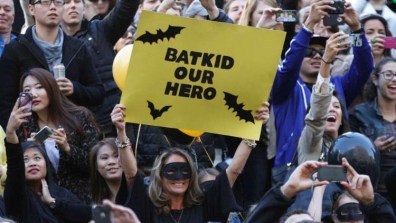 This massive effort, which was a viral media sensation, was orchestrated by the Make-A-Wish Foundation for Miles Scott, a five-year who has spent half his life struggling with leukemia. Having finished his course of chemotherapy, it was Scott’s dream to be Batman for a day. And now, a documentary called Batkid Begins, is retelling the story of Batkid, the Scott family, and how one kid’s wish went viral.
This massive effort, which was a viral media sensation, was orchestrated by the Make-A-Wish Foundation for Miles Scott, a five-year who has spent half his life struggling with leukemia. Having finished his course of chemotherapy, it was Scott’s dream to be Batman for a day. And now, a documentary called Batkid Begins, is retelling the story of Batkid, the Scott family, and how one kid’s wish went viral.
Director Dana Nachman has already raised nearly $40,000 (of her goal of $100,000) on Indiegogo to fund production. A one-time journalist, Nachman has made three films prior to this that were, in her own words, quite dark. As she explains:
I was looking for my next film to be uplifting. I didn’t even know about Batkid until after it happened, and I blown away that I had missed it, and was just so touched by the outpouring of support for this child.
Through a friend at NBC, where she formerly worked, Nachman was able to get a meeting with Make-a-Wish, which had already been approached by others wanting to do Batkid documentaries. Though Scott’s family had been reticent to do much press surrounding the Batkid event, they offered to work with Nachman on the film. After making their son’s wish come true, the Scott family hopes to raise awareness about the Foundation and the work it does.
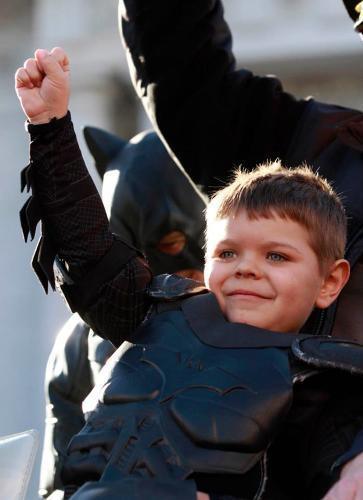 The three-act story will start with a focus on Scott and his experiences, segueing into the lead-up to the event itself as it went viral and everyone scrambled to keep up with the momentum. The third act will focus on the event itself, which involved Miles rescuing a damsel in distress from the train tracks, stopping the Penguin from kidnapping the San Francisco Giants seal mascot, and getting the key to the city from the mayor.
The three-act story will start with a focus on Scott and his experiences, segueing into the lead-up to the event itself as it went viral and everyone scrambled to keep up with the momentum. The third act will focus on the event itself, which involved Miles rescuing a damsel in distress from the train tracks, stopping the Penguin from kidnapping the San Francisco Giants seal mascot, and getting the key to the city from the mayor.
And though it might have seemed like the event was a media circus all on its own, it actually had quite the helping hand. The event went viral thanks in large part to the Clever Girls Collective, a content and social media agency that volunteered its time. As Nachman explained:
To me what’s interesting is that everyone approached for the [Batkid event] said, ‘Yes, I’ll participate and I’ll make it even cooler by doing this, this, and this.’ That’s the message of the film to me: ‘Yes, and.’ If I had my dream, that would be the title of it, but I think it’s a little too esoteric.
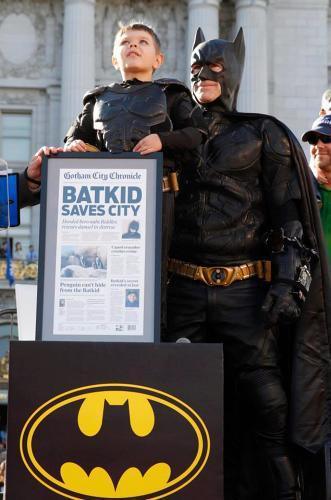 The $100,000 in funding that Nachman hopes to collect on Indiegogo will help out with animations, a soundtrack, and other production assets. A rough cut will be ready by the one-year anniversary of the Batkid event (this coming November), and the film will likely premiere early next year.I don’t know about you, but… a young boy who had a brush with death getting to live out his dream of being a superhero? I’m certainly going to see it! You got Miles Scott!
The $100,000 in funding that Nachman hopes to collect on Indiegogo will help out with animations, a soundtrack, and other production assets. A rough cut will be ready by the one-year anniversary of the Batkid event (this coming November), and the film will likely premiere early next year.I don’t know about you, but… a young boy who had a brush with death getting to live out his dream of being a superhero? I’m certainly going to see it! You got Miles Scott!
And in the meantime, check out the trailer for this heartwarming documentary below:
Sources: fastcoexist.com, (2)


News from Space: Coming Comet Flyby of Mars
 Earth’s neighbor is once again making the news, but not for the usual reasons. Rather than groundbreaking discoveries or updates being provided by the small army of rovers or satellites, the NASA has now got its eyes firmly fixed on the Red Planet because of an incoming comet. And in the coming months, NASA is taking every precaution to make sure its orbiting spacecraft are out of the way.
Earth’s neighbor is once again making the news, but not for the usual reasons. Rather than groundbreaking discoveries or updates being provided by the small army of rovers or satellites, the NASA has now got its eyes firmly fixed on the Red Planet because of an incoming comet. And in the coming months, NASA is taking every precaution to make sure its orbiting spacecraft are out of the way.
Known as C/2013 A1 Siding Spring, the comet’s icy nucleus is predicted to flyby Mars on Oct. 19th, and will miss the planet by just 132,000 km (82,000 miles). That’s 17 times closer than the closest recorded Earth-approaching comet, Lexell’s Comet, which skittered by our world in 1770. And while this is certainly a record-breaking event, no one is concerned about it damaging anything on the Martian surface.
 In fact, it the dust particles embedded in the comet’s vaporizing ice that concerns NASA planners. As dust spreads into a broad tail that could potentially brush Mars’ upper atmosphere, it could also play havoc with or even strike an orbiter. While tiny particles are hardly a hazard on their own, when they are traveling at 56 km (35 miles) per second relative to a spacecraft, a single impact could spell disaster.
In fact, it the dust particles embedded in the comet’s vaporizing ice that concerns NASA planners. As dust spreads into a broad tail that could potentially brush Mars’ upper atmosphere, it could also play havoc with or even strike an orbiter. While tiny particles are hardly a hazard on their own, when they are traveling at 56 km (35 miles) per second relative to a spacecraft, a single impact could spell disaster.
Rich Zurek, chief scientist for the Mars Exploration Program at NASA’s Jet Propulsion Laboratory in Pasadena, California, explains:
Three expert teams have modeled this comet for NASA and provided forecasts for its flyby of Mars. The hazard is not an impact of the comet nucleus, but the trail of debris coming from it. Using constraints provided by Earth-based observations, the modeling results indicate that the hazard is not as great as first anticipated. Mars will be right at the edge of the debris cloud, so it might encounter some of the particles — or it might not.
 Hence why NASA is looking to get its hardware out of the way. The agency currently operates the Mars Reconnaissance Orbiter (MRO) and Mars Odyssey spacecraft with a third orbiter, MAVEN, currently on its way to the planet and expected to settle into orbit a month before the comet flyby. Teams operating the orbiters plan to have all spacecraft positioned on the opposite side of Mars when the comet is most likely to pass by.
Hence why NASA is looking to get its hardware out of the way. The agency currently operates the Mars Reconnaissance Orbiter (MRO) and Mars Odyssey spacecraft with a third orbiter, MAVEN, currently on its way to the planet and expected to settle into orbit a month before the comet flyby. Teams operating the orbiters plan to have all spacecraft positioned on the opposite side of Mars when the comet is most likely to pass by.
Already, mission planners tweaked MRO’s orbit on July 2 to move it toward a safe position with a second maneuver to follow on August 27. A similar adjustment is planned for Mars Odyssey on August 5 and October 9 for the Mars Atmosphere and Volatile Evolution (MAVEN) probe. The time of greatest risk to the spacecraft is brief – about 20 minutes – when the widest part of the comet’s tail passes closest to the planet.
 As for the rovers on the surface, there really isn’t much to worry about there. Similar to what happens with meteor showers here on Earth, Mars’ atmosphere is thick enough that cometary dust particles will incinerate before they reach the surface. And its expected that rover cameras may be used to photograph the comet before the flyby and to capture meteors during the comet’s closest approach.
As for the rovers on the surface, there really isn’t much to worry about there. Similar to what happens with meteor showers here on Earth, Mars’ atmosphere is thick enough that cometary dust particles will incinerate before they reach the surface. And its expected that rover cameras may be used to photograph the comet before the flyby and to capture meteors during the comet’s closest approach.
Despite concerns about dust, NASA knows a good opportunity when it sees one. In the days before and after the flyby, all three orbiters will conduct studies on the comet. According to a recent NASA press release, instruments on MRO and Odyssey will examine the nucleus, coma and tail and possible effects on the Martian atmosphere:
Odyssey will study thermal and spectral properties of the comet’s coma and tail. MRO will monitor Mars’ atmosphere for possible temperature increases and cloud formation, as well as changes in electron density at high altitudes and MAVEN will study gases coming off the comet’s nucleus as it’s warmed by the sun. The team anticipates this event will yield detailed views of the comet’s nucleus and potentially reveal its rotation rate and surface features.
This is Comet Siding Spring’s first trip to the inner solar system, so we can expect plenty of news and updates as it passes Mars. And the icy vapor and dust it leaves behind, which has been in a state of deep freeze since the time the planets were formed, will make for some pretty interest research as well! And be sure to check out this Solar System Scope simulation of the comet’s path as it makes it way through our Solar System past Mars.
Source: universetoday.com, solarsystemscope.com


July 30, 2014
News From Space: Astronaut Robots
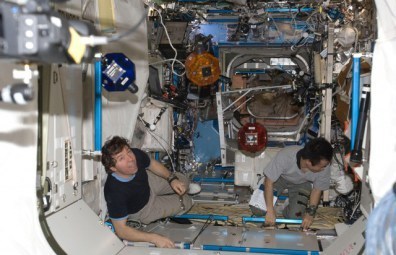 As if it weren’t bad enough that they are replacing workers here on Earth, now they are being designed to replace us in space! At least, that’s the general idea behind Google and NASA’s collaborative effort to make SPHERES (Synchronized Position Hold, Engage, Reorient, Experimental Satellites). As the name suggests, these robots are spherical, floating machines that use small CO2 thrusters to move about and performing chores usually done by astronauts.
As if it weren’t bad enough that they are replacing workers here on Earth, now they are being designed to replace us in space! At least, that’s the general idea behind Google and NASA’s collaborative effort to make SPHERES (Synchronized Position Hold, Engage, Reorient, Experimental Satellites). As the name suggests, these robots are spherical, floating machines that use small CO2 thrusters to move about and performing chores usually done by astronauts.
Earlier this month, NASA announced it’s plan to launch some SPHERES aboard an unmanned Cygnus spacecraft to the International Space Station to begin testing. That launch took place on July 11th, and the testing has since begun. Powered by Tango, Google’s prototype smartphone that comes with 3D sensors that map the environment around them, the three satellites were used to perform routine tasks.
 NASA has sent SPHERES to the ISS before, but all they could really do was move around using their small CO2 thruster. With the addition of a Tango “brain” though, the hope is that the robots will actually be able to assist astronauts on some tasks, or even completely carry out some mundane chores. In addition, the mission is to prepare the robots for long-term use and harmonized them to the ISS’ environment.
NASA has sent SPHERES to the ISS before, but all they could really do was move around using their small CO2 thruster. With the addition of a Tango “brain” though, the hope is that the robots will actually be able to assist astronauts on some tasks, or even completely carry out some mundane chores. In addition, the mission is to prepare the robots for long-term use and harmonized them to the ISS’ environment.
This will consist of the ISS astronauts testing SPHERES ability to fly around and dock themselves to recharge (since their batteries only last 90 minutes), and use the Tango phones to map the Space Station three-dimensionally. This data will be fed into the robots so they have a baseline for their flight patterns. The smartphones will be attached to the robots for future imaging tasks, and they will help with mathematical calculations and transmitting a Wi-Fi signal.
 In true science fiction fashion, the SPHERES project began in 2000 after MIT professor David W. Miller was inspired by the “Star Wars” scene where Luke Skywalker is being trained in handling a lightsaber by a small flying robot. Miller asked his students to create a similar robot for the aerospace Industry. Their creations were then sent to the ISS in 2006, where they have been ever since.
In true science fiction fashion, the SPHERES project began in 2000 after MIT professor David W. Miller was inspired by the “Star Wars” scene where Luke Skywalker is being trained in handling a lightsaber by a small flying robot. Miller asked his students to create a similar robot for the aerospace Industry. Their creations were then sent to the ISS in 2006, where they have been ever since.
As these early SPHERES aren’t equipped with tools, they will mostly just fly around the ISS, testing out their software. The eventual goal is to have a fleet of these robots flying around in formation, fixing things, docking with and moving things about, and autonomously looking for misplaced items. If SPHERES can also perform EVAs (extra-vehicular activity, space walks), then the risk of being an astronaut would be significantly reduced.
 In recent years there has been a marked shift towards the use of off-the-shelf hardware in space (and military) applications. This is partly due to tighter budgets, and partly because modern technology has become pretty damn sophisticated. As Chris Provencher, SPHERES project manager, said in an interview with Reuters:
In recent years there has been a marked shift towards the use of off-the-shelf hardware in space (and military) applications. This is partly due to tighter budgets, and partly because modern technology has become pretty damn sophisticated. As Chris Provencher, SPHERES project manager, said in an interview with Reuters:
We wanted to add communication, a camera, increase the processing capability, accelerometers and other sensors [to the SPHERES]. As we were scratching our heads thinking about what to do, we realized the answer was in our hands. Let’s just use smartphones.
The SPHERES system is currently planned to be in use on the ISS until at least 2017. Combined with NASA’s Robonaut, there are some fears that this is the beginning of a trend where astronauts are replaced entirely by robots. But considering how long it would take to visit a nearby star, maybe that’s not such a bad thing. At least until all of the necessary terraforming have been carried out in advance of the settlers.
So perhaps robots will only be used to do the heavy lifting, or the work that is too dull, dangerous or dirty for regular astronauts – just like drones. Hopefully, they won’t be militarized though. We all saw how that went! And be sure to check out this video of SPHERES being upgraded with Project Tango, courtesy of Google’s Advanced Technology and Projects group (ATAP):
Sources: nasa.gov, extremetech.com, techtimes.com


The Future is Here: Flexible, Paper Thin Ultra-HD Screens
 The explosion in computing and personal devices in recent years has led to a world where we are constantly surrounded by displays. Whether they belong to personal computers, laptops, smartphones, LCDs, PDAs, or MP3 players, there is no shortage to the amount of screens we can consult. In turn, this proliferation has led computer scientists and engineers to address a number of imperfections these displays have.
The explosion in computing and personal devices in recent years has led to a world where we are constantly surrounded by displays. Whether they belong to personal computers, laptops, smartphones, LCDs, PDAs, or MP3 players, there is no shortage to the amount of screens we can consult. In turn, this proliferation has led computer scientists and engineers to address a number of imperfections these displays have.
For instance, some of these displays don’t work in direct sunlight or are subject to glare. Others are horridly energy-inefficient and will drain their battery life very quickly. Some don’t have high-definition, rich color, and can’t display true black color. Just about all of them are rigid, and all can be broken given a solid enough impact. Luckily, a new age of flexible, ultra-HD screens are on the way that promise to resolve all of this.
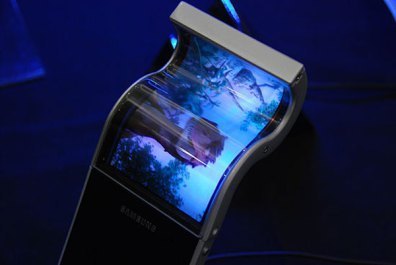 The first examples of this concept were rolled out at the 2011 Consumer Electronics Show, where Samsung unveiled its revolutionary new AMOLED display on a number of devices. This was followed up in September of 2012 when Nokia unveiled its Kinetic Device at the World Nokia Conference in London. Both devices showcased displays that could bend and flex, and were followed by concept videos produced by electronic giants Sony, 3M and Microsoft.
The first examples of this concept were rolled out at the 2011 Consumer Electronics Show, where Samsung unveiled its revolutionary new AMOLED display on a number of devices. This was followed up in September of 2012 when Nokia unveiled its Kinetic Device at the World Nokia Conference in London. Both devices showcased displays that could bend and flex, and were followed by concept videos produced by electronic giants Sony, 3M and Microsoft.
Since that time, numerous strides have been taken to improve on the technology before it hits the open market. In research published earlier this month in Nature, scientists describe what may be the first steps toward creating a new type of ultrathin, superfast, low-power, high-resolution, flexible color screen. If successful, these displays could combine some of the best features of current display technologies.
 The new displays work with familiar materials, including the metal alloy already used to store data on some CDs and DVDs. The key property of these materials is that they can exist in two states – when warmed by heat, light, or electricity, they switch from one state to the other. Scientists call them phase-change materials (PCMs); and as Alex Kolobov, a researcher at Japan’s Nanoelectronics Research Institute who was not involved in the new work, explains:
The new displays work with familiar materials, including the metal alloy already used to store data on some CDs and DVDs. The key property of these materials is that they can exist in two states – when warmed by heat, light, or electricity, they switch from one state to the other. Scientists call them phase-change materials (PCMs); and as Alex Kolobov, a researcher at Japan’s Nanoelectronics Research Institute who was not involved in the new work, explains:
It is really fascinating that phase-change materials, now widely used in optical and nonvolatile electronic memory devices, found a potentially new application in display technology.
A PCM display would work similar to the electronic paper used in products like Amazon’s Kindle reader. Both are made by sandwiching a material that has two states, one lighter and one darker, in between layers of transparent conductors. The inner material is a viscous black oil filled with tiny white titanium balls. To make a pixel black or white, a current is run through a tiny area of the glass to either pull the reflective balls to the front, or cause them to recede.
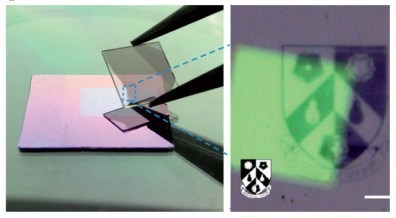 In a PCM display, the inner material is a substance made of silicon’s heavier cousins: germanium, antimony, and tellurium. The two states of this material (known as GST) are actually two different phases of matter: one an ordered crystal and the other a disordered glass. To switch between them, current pulses are used to melt a tiny column, and either cooled gently to make the crystal or rapidly to make the glass.
In a PCM display, the inner material is a substance made of silicon’s heavier cousins: germanium, antimony, and tellurium. The two states of this material (known as GST) are actually two different phases of matter: one an ordered crystal and the other a disordered glass. To switch between them, current pulses are used to melt a tiny column, and either cooled gently to make the crystal or rapidly to make the glass.
This cycle can be done remarkably quickly, more than 1 million times per second. That speed could be a big advantage in consumer products. While scrolling on a Kindle can be terribly slow because the screen only refreshes once per second, the refresh rate on a PCM display would be fast enough to play movies, stream videos, and perform all the tasks people routinely do with their devices.
 To make the new displays, the research team – led by Harish Bhaskaran, a nanoscale manufacturing expert from Oxford University – used a 35-year-old machine developed by the semiconductor industry. They then laid down three layers that were a few nanometers thick of conducting glass, GST, and another layer of conducting glass. Then they used current from the tip of an atomic force microscope to draw pictures on the surface.
To make the new displays, the research team – led by Harish Bhaskaran, a nanoscale manufacturing expert from Oxford University – used a 35-year-old machine developed by the semiconductor industry. They then laid down three layers that were a few nanometers thick of conducting glass, GST, and another layer of conducting glass. Then they used current from the tip of an atomic force microscope to draw pictures on the surface.
These images included everything from a Japanese print of a tidal wave to fleas and antique cars – each one smaller than the width of a human hair. With this sort of flexible, ultra-high resolution screen, a PCM display could be made into everything from a bendable laptop and personal device to a programmable contact lens — like Apple’s Retina Display, except that it would actually fit on your retina.
 Turning this technology into products will require years of labor and hundreds of millions of dollars. Nevertheless, Bhaskaran and his colleagues are optimistic. The electronics industry has lots of experience with all the components, so there are plenty of well-known tricks to try to improve this first draft. And they are hardly alone in their efforts to bring flexible displays to market.
Turning this technology into products will require years of labor and hundreds of millions of dollars. Nevertheless, Bhaskaran and his colleagues are optimistic. The electronics industry has lots of experience with all the components, so there are plenty of well-known tricks to try to improve this first draft. And they are hardly alone in their efforts to bring flexible displays to market.
For instance, LG unveiled their new line of flexible OLED TVs at CES earlier this year. Now, they are taking things a step further with the unveiling of two new 18-inch OLED panels, the first of which is a transparent display, while the second can be rolled up. Although both fall short of the 77-inch flexible TV on show at CES, the company says the new panels prove that it has the technology to bring rollable TVs with screens in excess of 50 inches to market in the future.
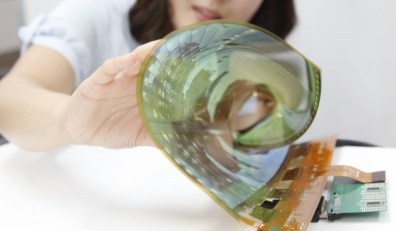 Unlike their 77-inch flexible TV that has a fairly limited range of changeable curvature, LG Display’s latest flexible OLED panel can be rolled up into a cylinder with a radius of 3 cm (1.18 in) without the function of the 1,200 x 810 pixel display being affected. This is made possible though the use of a high molecular substance-based polyimide film to create the backplane, rather than conventional plastic .
Unlike their 77-inch flexible TV that has a fairly limited range of changeable curvature, LG Display’s latest flexible OLED panel can be rolled up into a cylinder with a radius of 3 cm (1.18 in) without the function of the 1,200 x 810 pixel display being affected. This is made possible though the use of a high molecular substance-based polyimide film to create the backplane, rather than conventional plastic .
The transparent OLED panel, on the other hand, was created using LG Display’s transparent pixel design technology. With transmittance of 30 percent, the company says the panel is superior to existing transparent LCD panels that generally achieve around 10 to 15 percent transmittance. LG Display claims to have also reduced the haze of the panel, caused by circuit devices and film components, to just 2 percent.
 As In-Byung Kang, Senior Vice President and Head of the R&D Center at LG Display, explained:
As In-Byung Kang, Senior Vice President and Head of the R&D Center at LG Display, explained:
LG Display pioneered the OLED TV market and is now leading the next-generation applied OLED technology. We are confident that by 2017, we will successfully develop an Ultra HD flexible and transparent OLED panel of more than 60 inches, which will have transmittance of more than 40 percent and a curvature radius of 100R, thereby leading the future display market.
Granted, it will be still be a few years and several hundred million dollars before such displays become the norm for computers and all other devices. However, the progress that is being made is quite impressive and with all the electronics megagiants committed to making it happen, an age where computing and communications are truly portable and much more survivable is likely just around the corner.
Sources: wired.com, gizmag.com, extremetech.com



